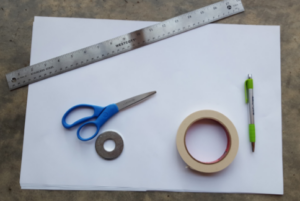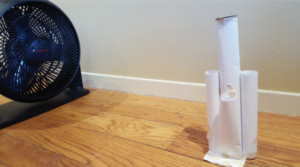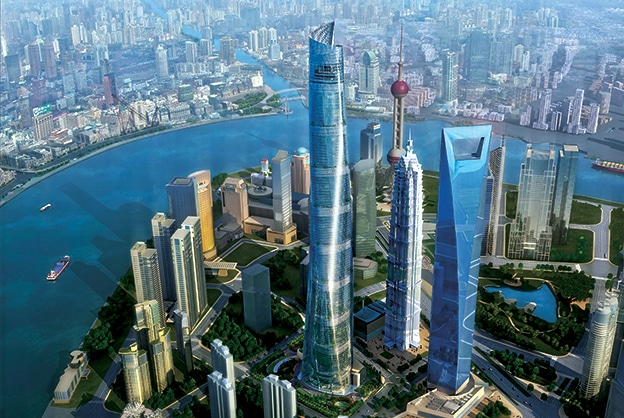Overview
Materials
Supplies & Equipment:
|
Consumables:
Optional:
|

Relevant Terminology
Lateral force: A force in a horizontal direction that pushes against a wall or building. Wind is an example of a lateral force.
Wind load: The force of wind as it pushes and pulls on a building.
Wind tunnel testing: A means of testing how a building, car, or aircraft will do when a certain amount of wind is generated. It enables engineers to study how the wind moves around the object they are testing.
Introduce
GETTING READY
Designate an area for testing that is large enough for the fan to blow on the towers unimpeded. You will need to start with at least 10 feet between the fan and each tower.
INTRODUCTION
For younger participants, provide context for this activity by asking some questions, such as:
- Have you ever been in a wind storm? What happened?
- When you have been inside during a very windy storm, have you felt the building shake?
- Why do you think trees can withstand very strong winds? When they don’t, what do you think went wrong?
- Why do you think the little pig with the brick house stood up to the wolf’s huffing and puffing, but the straw house and the house of sticks could not?
Instructions
Introduce the design challenge to participants. They can use 4 sheets of paper and 2 yards of tape to make a tower that will stay in place with as much wind blowing on it as possible, with the following constraints:
- It must hold a metal washer at least 14″ above the ground
- It is free standing (not taped or attached to the testing surface)
- You may trade in your paper and tape for a completely fresh set to try a new design.
Tell participants to plan their tower first and think about what design elements will provide the most stability but not catch too much wind.
 Place the fan on the floor off to the side and turn it on so participants can test their creations as they are ready. Depending on the fan, decide which speed is strong enough to affect towers that get close, but not so strong that most of the towers blow away from a farther distance.
Place the fan on the floor off to the side and turn it on so participants can test their creations as they are ready. Depending on the fan, decide which speed is strong enough to affect towers that get close, but not so strong that most of the towers blow away from a farther distance.
Have participants place their tower (with metal washer on top) about 10 feet away from the fan and then move it closer a little at a time until it is affected by the wind. For each tower, record the distance between the base of the fan and the front edge of the tower. See who can design the tower that can stand still closest to the fan.
ACTIVITY VARIATIONS
Vary the amount of paper and/or tape
Vary the type of paper
Vary the required height
Allow participants to attach the structure to the testing surface
Vary the fan speed
TROUBLESHOOTING
If participants’ designs are blowing over very easily and they are getting frustrated, give them a hint, but as small a hint as you can so that participants have the satisfaction of coming up with a design on their own. An example of a hint: What would happen if you made the base of your tower wider?
Guiding questions
GUIDANCE FOR YOUNGER CHILDREN
QUESTIONS TO ASK AFTER THE ACTIVITY
- What did you think about to start your tower?
- What were the first steps you took to build your tower?
- Did your tower slide rather than blow over, or the other way around? Why?
- Did your tower do as well as you thought it would?
- What could you change to make your tower even stronger against wind?
- Which tower shapes work better than others?
- How is your tower different from real highrise structures?
- What prevents real towers from sliding like your tower might have?
GUIDANCE FOR OLDER YOUTH AND ADULTS
QUESTIONS TO ASK AFTER THE ACTIVITY
- How did you go about planning your tower?
- What factors did you take into account as you designed your tower?
- What were the results of the first test?
- If you went back to the drawing board, what changes did you make and why?
- How do you think this process mimics the real process engineers use to build new structures?
Engineering & science connections
GUIDANCE FOR YOUNGER CHILDREN
Engineering Connections
The little pig who built a brick house might have been an engineer. She knew how to make a house so strong it could stand up to the lateral force of the wolf huffing and puffing on it! Engineers make all buildings as strong as they can so that they won’t blow over during a storm. Very tall buildings, like skyscrapers, have to be built in special ways so that they don’t just topple when strong winds slam into them.
Engineers like to test their ideas for tall buildings before they go ahead and build them. For example, they make models of their ideas and put them in wind tunnels. Then they make different strengths of wind blow on the model in the tunnel. If the model doesn’t fall over or fall apart, even if the engineers make a really strong wind blow on it, then they know the building will be strong in a storm too.
Science Connections
Wind is a lateral force. It blows sideways. When wind blows on a building, it puts pressure on it. But the pressure is different depending on what part of the building it is blowing on. And different parts of a building respond differently when the wind blows on them too. For example, a gust of wind hits the glass in a window. Sometimes it makes the window rattle. That same wind, when it blows on a chimney, whooshes around the sides of the chimney instead of slamming it, so it makes less pressure.
Engineers know how to use math and computers to figure out how much force the wind is putting on different parts of a structure. They also use math and computers to help them decide how strong each part of the structure needs to be. This way, when they build a new building, they aren’t just guessing and hoping for the best!
GUIDANCE FOR OLDER YOUTH AND ADULTS
Engineering Connections
Whenever civil, mechanical, and structural engineers design structures such as towers, they take high winds and other lateral forces into account in order to create as much stability and strength as possible. Wind tunnel testing allows engineers to see what happens to different shapes and materials when subjected to the many kinds of wind any building will eventually have to withstand. Wind tunnel testing averts disasters such as the collapse of the Tacoma Narrows Bridge.
Wind tunnel testing also enabled engineers to design a special shape for the Shanghai Towers. This shape reduced the wind load that typical rectangular skyscrapers have to bear and shaved millions of dollars off the price tag of materials. This is no small accomplishment: at over 2,000 feet tall, with 128 stories, the Shanghai Tower is often subjected to very powerful winds. It’s not just the structure itself that has to survive, it’s the different elements of the structure as well. Think about roofs ripping off of houses, or shingles getting torn off a house in a bad storm.
Science Connections
Scientists and engineers use tools such as mathematical formulas, computational fluid dynamic computer software, and wind tunnels to predict the effects of wind more accurately than ever before. Wind is a significant lateral force—a pressure that hits an object sideways. Before the advent of technology, predicting how wind would affect a structure was much more difficult. Now scientists can analyze these complicated currents and design for strength and durability in new ways.
Of course a structure’s materials have to be analyzed for their ability to withstand wind. Other wind-related factors include the structure’s height, weight, and means of anchorage to the ground. If a building is very tall, scientists also consider the degree to which it will sway in a strong wind. People prefer buildings to do as little of that as possible!
Activity created by Mindful Solutions Inc. for the American Society of Civil Engineers. All rights reserved.
Shanghai Tower photo credit and copyright © Gensler
Supplemental content adapted for Dream Big Activities by the Carnegie Science Center.


0 Comments